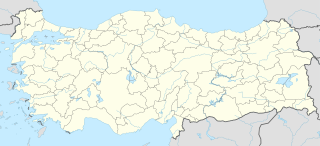 W
WThe Armenian Kingdom of Cilicia, also known as Cilician Armenia, Lesser Armenia, or New Armenia and formerly known as the Armenian Principality of Cilicia, was an Armenian state formed during the High Middle Ages by Armenian refugees fleeing the Seljuk invasion of Armenia. Located outside the Armenian Highlands and distinct from the Kingdom of Armenia of antiquity, it was centered in the Cilicia region northwest of the Gulf of Alexandretta.
 W
WThe Cilicia earthquake occurred northeast of the city of Adana in 1268. Over 60,000 people perished in the Armenian Kingdom of Cilicia in southern Asia Minor.
 W
WAkner monastery is a destroyed Armenian monastery near the Eğner village of Adana province of modern Turkey.
 W
WThe Alara Castle, is a historic fortification located at Alanya district of Antalya Province in southern Turkey.
 W
WThe castle of Amouda Crusader castle, formerly in the Armenian Kingdom of Cilicia, and today in the Turkish Province of Osmaniye. The castle was deeded by the Armenian king Levon I to the Teutonic Knights in 1212 and rebuilt by them in the 13th century. It earned revenue for the Teutonic Order from the surrounding land. According to contemporary sources, the castle provided shelter for 2,200 people during the invasion by the Mamluks in 1266.
 W
WMongol Armenia or Ilkhanid Armenia refers to the period in which both Armenia and the Armenian Kingdom of Cilicia became tributary and vassal to the Mongol Empire in the 1230s. Armenia and Cilicia remained under Mongol influence until around 1335.
 W
WArqakaghni monastery, was an Armenian monastery in the western part of Adana province of modern Turkey, which lies 9 km southeast of Mamestia, a city in the east of Cilician plain.
 W
WDrazark monastery, a destroyed monastic complex of Armenian Apostolic Church in Adana province of modern Turkey, which lies about 40 km. northwest of the city of Sis - historical capital of Cilician Armenia, at one of inaccessible slopes of Cilician Taurus range.
 W
WThe Armenian Catholicosate of the Great House of Cilicia is an autocephalous Oriental Orthodox church. Since 1930, the Catholicosate of the Great House of Cilicia has been headquartered in Antelias, Lebanon. Aram I is the Catholicos of Cilicia of the Armenian Apostolic Church since 1995.
 W
WThe House of Lusignan was a royal house of French origin, which at various times ruled several principalities in Europe and the Levant, including the kingdoms of Jerusalem, Cyprus, and Armenia, from the 12th through the 15th centuries during the Middle Ages. It also had great influence in England and France.
 W
WKozan is a city in Adana Province, Turkey, 68 kilometres northeast of Adana, in the northern section of the Çukurova plain. The city is the capital of the ilçe (district) of Kozan. The Kilgen River, a tributary of the Ceyhan, flows through Kozan and crosses the plain south into the Mediterranean. The Taurus Mountains rise up sharply behind the town.
 W
WMamure Castle is a medieval castle in the Anamur District of Mersin Province, Turkey.
 W
WMopsuestia is an ancient city in Cilicia Campestris on the Pyramus River located approximately 20 km (12 mi) east of ancient Antiochia in Cilicia. From the city's harbor, the river is navigable to the Mediterranean Sea, a distance of over 40 km (24 mi).
 W
WSis was the capital of the Armenian Kingdom of Cilicia. The massive fortified complex is just to the southwest of the modern Turkish town of Kozan in Adana Province.
 W
WYumurtalık is a resort town and a district in the Adana Province of Turkey. It was formerly called Aegeae, Ayas or Laiazzo. It is a Mediterranean port at a distance of about 40 km (25 mi) from Adana city. Yumurtalık's population does not exceed 5,000 in winter, but in summer, it rises to 30 to 40,000 people since many inhabitants of Adana have holiday homes here. There are also many daily visitors during the holiday season.